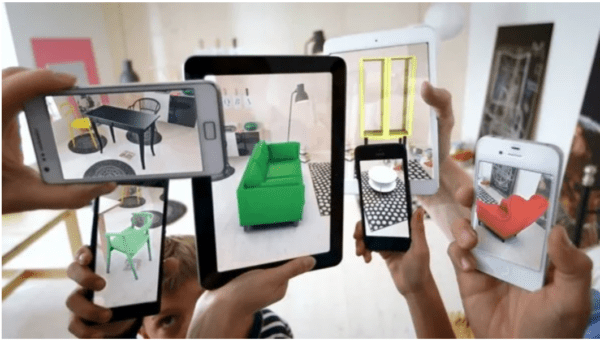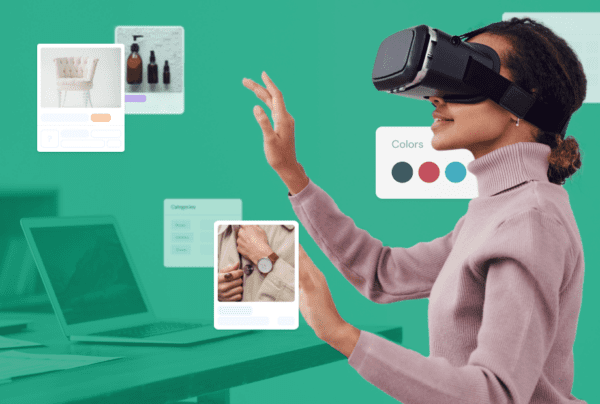Augmented reality (AR) is a technology that overlays digital information in the real world, allowing users to interact with digital objects in a physical space. In the ecommerce context, AR can give customers a better understanding of what a product will look like in real life. For example, a furniture company could use AR to allow customers to see what a couch would look like in their living room before purchasing. This can help customers make more informed buying decisions and reduce the likelihood of returns.
If you’re an avid online shopper, you’ve probably experienced the frustration of receiving a product that doesn’t quite meet your expectations. Maybe the colour was different, or the size didn’t fit as you had hoped. With the rise of ecommerce, it’s become more accessible than ever to purchase products online, but knowing precisely what you’re getting can still be challenging. That’s where augmented reality comes in.
As AR technology continues to improve, it’s becoming more accessible to ecommerce businesses of all sizes. In this article, we’ll explore how AR is used in ecommerce, the benefits it offers businesses and customers and the future of AR in ecommerce.

The Rise of Augmented Reality in Ecommerce
As technology continues to evolve, it is becoming increasingly clear that Augmented Reality (AR) is the future of ecommerce. AR overlays virtual objects onto the real world, creating an immersive user experience. This technology has revolutionized how consumers shop online, allowing them to interact with products virtually before purchasing.
Understanding AR and Its Impact on Ecommerce
AR has had a significant impact on ecommerce. It has transformed how consumers shop online by providing a more immersive experience. With AR, consumers can interact with products virtually, which helps them to make more informed purchasing decisions. This technology has also helped businesses to reduce the risk of returns and increase customer satisfaction.
AR has also changed the way businesses market and advertise their products. With AR, businesses can create interactive advertisements that allow consumers to see how products will look in their homes before purchasing. This has helped companies to increase their conversion rates and attract more customers.
Key AR Technologies Revolutionizing Online Shopping
Several key AR technologies are revolutionizing online shopping. These technologies include:
- Virtual Try-On: This technology lets customers try on clothes virtually before purchasing. This helps customers to find the right fit and reduces the risk of returns.
- Virtual Showrooms: With virtual showrooms, customers can see how products look in their homes before purchasing. This technology has revolutionized the way consumers shop for furniture and home decor.
- AR Product Demos: AR product demos allow customers to see how products work before purchasing. This technology has benefited businesses that sell complex products, such as electronics.

AR is transforming the ecommerce industry. It has revolutionized how consumers shop online and helped businesses increase their sales and attract more customers. AR technology is expected to become even more prevalent in the ecommerce industry as it evolves.
Enhancing Customer Experience with AR
Augmented reality (AR) technology has revolutionized how customers interact with products and brands. By blending the virtual and physical worlds, AR provides an immersive and interactive shopping experience that transcends traditional boundaries. This section will discuss how AR enhances customer experience in e-commerce.
Virtual Try-On Solutions
One of the most significant benefits of AR in e-commerce is virtual try-on solutions. AR-powered virtual try-on solutions allow customers to see how products look on them without trying them on physically. This feature is handy for fashion and beauty products, where customers can try on clothes, makeup, and accessories virtually. Virtual try-on solutions help customers make more informed purchase decisions and reduce the likelihood of returns.
Immersive Experiences and Customer Engagement
AR technology provides customers an immersive experience that engages them with the brand and its products. For example, customers can use AR to visualize home furniture, see how a car looks in their driveway, or try virtual makeup. This immersive experience helps customers connect with the brand and its products on a deeper level, leading to increased engagement and brand loyalty.
Reducing Returns Through Accurate Product Visualization
AR technology helps reduce returns by providing customers with accurate product visualization. Customers can see how products look and fit in real time, reducing the likelihood of returns due to inaccurate product descriptions or images. By reducing returns, brands can save on shipping costs and improve their bottom line.
AR technology enhances customer experience in e-commerce by providing virtual try-on solutions, immersive experiences, and accurate product visualization. By leveraging AR technology, brands can engage customers deeper, reduce returns, and improve their bottom line.

AR in Retail: Success Stories and Applications
Augmented Reality (AR) has revolutionized the way people shop online. AR technology allows users to visualize products in real time and in a more personalized way, which enhances the overall shopping experience. In this section, we will discuss some of the successful applications of AR in the retail industry.
Furniture and Home Decor: The IKEA Place App
A leading furniture retailer, IKEA has successfully implemented AR technology through its IKEA Place app. The app allows users to visualize how furniture will look in their homes before purchasing. Customers can place virtual furniture in their room using the camera on their device and see how it fits in real-time. This AR integration has resulted in a massive retail rollout of 7+ IKEA stores in the UAE.
Fashion and Accessories: Virtual Fitting Rooms
Virtual fitting rooms are a game-changer for the fashion industry. AR technology allows customers to virtually try on clothes and accessories, eliminating the need for physical fitting rooms. Brands like Adidas have implemented AR technology to create virtual shoe try-ons. Customers can see how the boots look on their feet without actually trying them on. This not only saves time but also enhances the overall customer experience.
Cosmetics and Makeup: The Rise of Virtual Makeovers
AR technology is also transforming the cosmetics industry. Makeup brands like Sephora and L’Oreal have implemented AR technology to create virtual makeup try-ons. Customers can see how different makeup products look on their faces without applying them. This technology has not only increased customer engagement but has also led to an increase in sales.
In conclusion, AR technology has transformed retail by providing a more personalized and engaging shopping experience. By implementing AR technology, retailers can increase customer engagement, reduce returns, and ultimately increase sales.
Challenges and Considerations for AR in Ecommerce
Augmented Reality (AR) is a powerful tool for ecommerce businesses to improve customer engagement and increase sales. However, implementing AR in ecommerce has various challenges and considerations that must be addressed. This section discusses the challenges and concerns for AR in ecommerce.
Technical Challenges and User Adoption
One of the primary challenges of implementing AR in ecommerce is the technical limitations of the devices and hardware. AR apps require high-performance devices with advanced cameras and sensors to deliver a seamless AR experience. This can be a challenge for customers who may not have access to high-performance devices or are uncomfortable using AR technology.
Another challenge is user adoption. Customers may hesitate to adopt AR technology due to its unfamiliarity or concerns about privacy and security. To overcome this challenge, ecommerce businesses need to educate their customers about the benefits of AR and provide a user-friendly AR experience.
Data Privacy and Security Concerns
AR technology involves using cameras and sensors to capture user environment data. This raises concerns about data privacy and security. Ecommerce businesses must ensure that they collect and use data ethically and transparently.
To address these concerns, ecommerce businesses must implement robust data privacy and security measures. This includes using secure data storage, implementing data encryption, and providing customers with clear and concise privacy policies.
Implementing AR in ecommerce involves various challenges and considerations. By addressing these challenges and concerns, ecommerce businesses can deliver a seamless AR experience that improves customer engagement and increases sales.
Future Trends and Developments in AR and Ecommerce
As ecommerce continues to grow, it’s essential to stay ahead of the trends and developments that will shape the industry in the coming years. Integrating augmented reality (AR) into ecommerce platforms is one of the most exciting developments. This technology allows customers to visualize products in 3D and real-world environments, making informed purchasing decisions and making machine learning more accessible.
As AR technology continues to evolve, it will be essential to integrate artificial intelligence (AI) and machine learning (ML) into ecommerce platforms. AI and ML can help improve the accuracy of product recommendations and provide personalized shopping experiences. This technology can also help retailers better understand their customer’s preferences and behaviour, allowing them to tailor their offerings to meet their needs.
Integrating AR with the Metaverse and Social Commerce
Another exciting development in AR and ecommerce is the integration of AR with the metaverse and social commerce. The metaverse is a virtual world where users can interact with each other and digital objects in a 3D environment. Integrating AR with the metaverse can provide customers with a more immersive shopping experience, allowing them to see products in a virtual environment and interact with them in new and exciting ways.
Social commerce is another area where AR and ecommerce intersect. Social media platforms are increasingly becoming shopping destinations, and integrating AR technology into these platforms can help retailers reach a wider audience and provide a more engaging shopping experience.
Market research shows that AR is expected to grow significantly in the coming years, with a projected value of $72.7 billion by 2024 [1]. As AR technology continues to evolve and become more accessible, ecommerce platforms must integrate this technology to remain competitive and provide customers with the best shopping experience.
[1] Source: Mordor Intelligence







